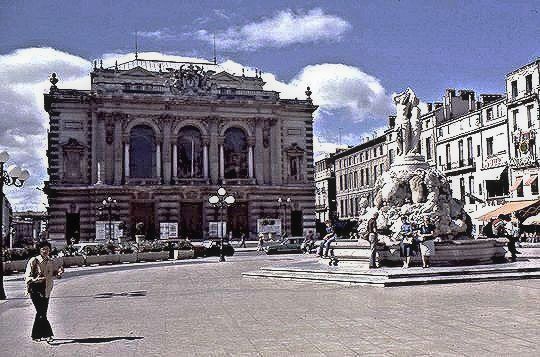
L’Oeuf in the center of Montpellier and the Theater. On the right, the awnings of Y’a bon or Y’a mieux.
Montpellier is a very old city close to the coast in Languedoc, west of Provence and la Côte d’Azur, which non-French people call the Riviera. I had spent well over a month there in 1959 teaching French to young Swedes in a Swedish summer school and I had gotten to like the city very much. You do need someone to take you to the beaches by car, but it was usually easy to arrange.
In 1961 I decided I wanted to return to this beautiful old city where the great writer François Rabelais went to medical school at one of the oldest universities in France. He got his medical degree from the Montpellier university in the early 1500s.
As far as the layout of the city foes, there is a beautiful plaza, even though it’s been transformed, and not necessarily for the better. The center of the downtown Montpellier is called l’Œuf (the egg), but it has now lost the shape of an egg that gave it the nickname.
On the northern side of l’Œuf are two cafés that are in a way the very heart of the city. People have baptized them “Y’a bon” and “Y’a mieux”. — “There’s good ” (food and drink) and “There’s better”. That’s where you meet your friends and make new friends. I hope those two pillars of tradition and humor have not changed too much.
Next to the cafés is the main street, la rue de la Loge, that goes through the old city, past tiny alleys where no cars can drive, only motor cycles, mostly scooters in those days, and up to the gorgeous old water tower, le château d’eau du Peyrou, with its aqueduct, dating from the 17th century.
It must be the most beautiful water tower ever built anywhere. It’s a historic landmark and a work of art.
I had made friends with some young Swedish girls from that year’s summer school and we used to go to the beach together, hitchhiking if there was no other offer available. As long as you were not alone, it was all right.
Then one day there was one of those hard afternoon cloudbursts that are very frequent on the coast and I was alone in the area of the two standard cafés. The whole scene was reminiscent of Georges Brassens’ song ‘Le parapluie’, even though in this case it was not about an umbrella but a huge sunshade in a café.
Il pleuvait fort sur la grand-route
Elle cheminait sans parapluie
J’en avais un, volé, sans doute
Le matin même à un ami 1
I was looking for shelter and found a table at Y’a mieux where there was one beautiful young woman sitting alone, sipping on a menthe à l’eau. There was not a single table free, so I asked her if I could sit down – Vous permettez? – putting my hand on the back of a chair. She nodded very nicely and we started talking. Her name was Michèle. I was going to get to know her better.
I had just had the time to order ‘un express’ (as the French say for an espresso) when along came a young man, a friend of Michèle’s, who asked if he could join us and get out of the pouring rain. So there we were, the three of us, talking about this and that. After a while the rain had stopped and Michèle got up to leave.
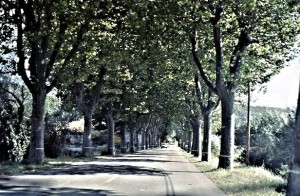
A typical road in ‘le Midi’, lined with platanes, plane-trees — the typical road to the sea from Montpellier.
The young man’s name was Jean. He was very bavard (talkative) and so was I and after a while, he suggested we drive in his little Citroën 2-chevaux (tax horses, not engine), to Palavas-les-flots on the sea. It sounded nice, and we ended up sitting talking at a table in a café as the dark settled around us. We were right by the canal on the tiny harbor in Palavas. Bell buoys were clanging out at sea and street lights were blinking through the leaves of trees. I had forgotten where I was and was just listening to the young man across from me.
Jean told me he was married and had two very young children, even though he was younger than I. He had married a young Jewish woman, Thérèse, who had miraculously survived the Nazi razzias in Paris. They were both Parisians. During the occupation there was no public transportation in Paris. The entrances to the metro were marked ‘Entrée interdite’ and there were strong metal gates to keep people from getting through.
One day after it got known that there had been an SS roundup in Jewish homes, a young boy, a cousin of Thérèse, walked through the whole city of Paris, from the north to the south, to find out if anybody was left in his cousins’ home. All he found was the baby. Most likely the SS men had found it too complicated to carry off a baby and so Thérèse was the only survivor of her family. She was saved by her cousin who was just a young boy at the time and who carried her back in his arms to his own home, the long way through the occupied city of Paris. His own family had obviously not been found by the SS.
Paris was a dead city during the occupation. The streets were mostly empty and the Germans dominated it all. They had their major Headquarters at the Place de la Concorde and just about the only cars to be seen in the streets were German military vehicles. If there were any French private drivers, they were certainly collaborators. Of course there was no gasoline for cars and at the time there were not that many private cars to begin with.
There were beautiful horse-drawn taxi carriages during the war and, oh yes, there were even rickshaws, bicycle-run tiny carts, vélo-taxi.
And of course there were bikes, people riding their bikes down the middle of Avenue de l’Opéra, everywhere bikes and more bikes. You can see all of this in documentaries from that era and it really looks like a halfway-dead city. Men even pulled heavy loads on carts, right in the streets, in the same streets where masses of cars now make it almost impossible for pedestrians to cross the street. This is like a scene from a third-world country, only the throngs of people missing.
Lots of Parisians fled to the south as long as it was still an unoccupied zone (la zone libre). Jean-Paul Sartre and Simone de Beauvoir went to the South to go biking on their vacation.2 This last chance to get away didn’t last though. In November 1942 the Germans took over the South as well. France had become a totally occupied country.
_____________________
Well, back to the café in Palavas-les-flots. After all this talking and listening we went to dance at a café–dancing called le Relai close to Montpellier where a crowd of his friends had assembled. We danced and there was also some drinking of scotch, which surprised me . Scotch in France was a first for me.
I think you can imagine how this evening ended. We were helplessly bewitched.
My vacation was approaching its end. I was going to do my student teaching in a Stockholm lycée and I had to get back and find a place to live, among other things.
It seems odd that neither one of us minded Jean’s being married and having two small children. We were thoughtlessly selfish. We were an island and nothing except the two of us really existed.
I of course did not know his wife and children, so it was probably easier for me to forget. Jean was staying in Montpellier for the summer to catch up on a failed year in medical school. He was already an oenologist, a wine scientist. He and his friend Jean-Jacques had gone through that school together and Jean-Jacques went on to become a very successful professional oenologue.
However, Jean decided that he definitely wanted to study medicine. (He became a psychiatrist, and he says now that he made that decision to please his mother.) His family had gone to stay with his parents in Sèvres, a suburb west of Paris and he was supposed to spend his time seriously studying. However, it must have been easy to compartmentalize, as it’s called these days. His married life was one thing and he and I another thing altogether. The one didn’t have anything to do with the other, somehow. We were so swept away by feelings that we did not seem to be aware of anything but us. Looking back it seems almost unbelievable how this passionate love saga was possible at all.
It got to be a couple of intense weeks of nothing but blue skies, beaches and beautiful grassy sand dunes, strolling around the old streets in Montpellier and having a pastis or a coffee at Y’a bon or Y’a mieux. And there were inexpensive meals in little restaurants that certainly don’t exist any more today.
One lunch-time, I remember so well there was a group of six of us, I think. It was hotter than Hades and we went into a restaurant that may have been air-conditioned. (Movie theaters at that time always announced outside “salle climatisée“, a term that was self-explanatory.) Anyway, we sat down around a big table and when la patronne came to ask us what we wanted to order we said “du melon“. It was just exactly what we wanted, nice cold tasty melon. After that the nice woman came back and said “Et ensuite?” We said “du melon”. Everybody laughed, but the woman didn’t mind. That was our lunch that day. I remember it was a restaurant just south of l’Œuf, and we were the only guests. It was too hot to move, so nobody else moved at noontime.
To go to the beach we mostly drove to Carnon-Plage in Jean’s little 2-chevaux. It was so very different in those days, the beaches unspoiled by huge vacation apartment buildings and an excess of tourism. There were lots of bathers and ball players, like on all French beaches, but nothing that spoiled the serenity and beauty of the sea and the grass-covered dunes. Also, the Mediterranean was still clean in those days.
Jean-Jacques was always the driver. One evening as the sun was already low in the west, coming back from Carnon-Plage, Jean and I were sitting in the back. I was on the left against the setting sun. Jean looked at me and said ‘Comme tu peux être belle…’ A never forgotten memory.
The modest and sympathiques little restaurants may not exist any more, but Y’a bon and Y’a mieux are still there, even though the plaza has changed a lot from what it was like in 1961 and l’Œuf doesn’t look much like an egg any more. No more cars, only a vast walking area and the fountain with La fontaine des Trois Grâces. Which is fine, but I miss l’Œuf.
And where there used to be the big department store Galeries Lafayette, on the horth side of l’Œuf. there is now — what? McDonald’s of course. And several more cafés and restaurants.
I was getting into a world I had only experienced from another angle – France and French culture. I had made myself feel at home in France during my seven months in Luxeuil-les-Bains as a teenager, even having to go to church (because of the old aunts in the château in Ecquevilley, Tata and Mémé, who absolutely required it). I had seen working-class women dressed in black doing their washing at les lavoirs in rue des Lavoirs in Luxeuil, close to our beautiful house. I had seen the little old women, also dressed in black at the time, sitting on kitchen chairs on the sidewalk in front of their houses in Saint-Sauveur, a neighboring little village that I liked to walk to and then continue on to the Roman road in the forest. I knew about French marchés where you buy everything from food to flowers and tennis shoes, at the time usually called des basquettes. Basketball was the favorite sport of our boyfriends, Gaëtane’s and mine, and we sometimes went to watch them play a game. We would buy hot wine from a kiosk set up for the occasion.
But this was another thing altogether. Jean introduced me to a French world that I knew very little of. He got me to know one of my absolutely favorite French singers and poets, Georges Brassens (Une jolie fleur dans une peau d’vache / Une jolie vache déguisée en fleur3). We read Jacques Prévert together, a leftist poet whom I had never heard of. I loved him. 4
And we read Pantagruel by Rabelais and poems by François Villon, whom I had barely read before. There was just no end to all the various untraveled roads Jean opened up to me. But I also remember when he said Oh, quelle chance tu as de pouvoir lire Faulkner dans la langue originale 5 He told me about his favorite writers and painters, Céline and his novel ‘Voyage au bout de la nuit’, and Matisse, his favorite painter. He is still today one of my favorites, along with the other fauvistes, such as Derain, and Vlaminck in his fauvist period, even though my really favorite painter from that period may still be Cézanne.
I still have two of those three reproductions by Matisse up on a wall at home in Genas, even though we are getting short on wall space. As for Cézanne, I love his landscapes and his still lifes.
In my classroom in Mamaroneck High School, a few years later, I had reproductions of Matisse and Cézanne and Derain on the walls. A still life by Cézanne with apples that I am in love with.
I talked and talked and talked to Jean about Sweden, about our travels in Lapland and the Sami people we had known. He said I can’t believe you are telling me about all these things. It is so exotic to me it’s as if you were talking about Eskimos and Greenland. We had in fact gotten to know many Sami people quite well when I was a young girl and I had real stories to tell Jean about. Sweden was an exotic country to Jean and I was surprised since to me the word “exotic” has always been associated with the south.
One day we drove to Sète, west of Montpellier on the coast because Jean wanted me to meet a friend of his, Masri, a painter. Masri had grown up as a French speaker in Egypt, and apparently there are many of those French speaking Half Egyptians who have moved back to their homeland.
At this ttime Masri was a budding painter, but he got to be a real professional. I like his paintings, of which our friend Jean-Jacques has quite a few. Too much primary colors says John though. Masri refused to go through a gallery to sell his paintings because, he said, they pocket half the value of the paintings. Too stubborn for his own good, since the outcome was that he did not sell very much, and Jean-Jacques contributed very much to his livelihood by buying his paintings regularly. His home with Christiane, his wife, was a gallery in itself for Masri’s paintings. I liked them very much even though, yes, Masri uses mainly primary colors.
On this day in Sète, we were in the courtyard where Masri and his wife lived, and Masri yelled at us to come on up. Well, the visit ended up with our looking at Masri’s portfolio of several kinds of experimental paintings. Jean wanted to get one for me, so I was supposed to pick one I liked particularly.
We got to one that I found very special, and I said “That one I really like.”
It was one of Masri’s experimental techniques where he painted on a
piece of coarse paper and then pressed the painting against a papier buvard (blotting paper) so that the contours became somewhat unfocused. Jean absolutely agreed, and so the deal was struck. I don’t know though, that Masri ever got paid for Jean’s gift to me, which therefore actually became a gift from Masri — maybe. We still have this painting up on a wall, even though it has become quite a bit faded. (Mother said when she saw it on the wall, all framed in the apartment on Östermalm in Stockholm I co-rented with my friend Brita Wolfram “The tablecloth is very nice. She was right.)
We also got away with a stack of beautiful postcards with ink drawings by Masri. I liked them a lot but sadly they have gotten lost in one of my many moves. There was one of “des joueurs de pétanque” that I remember particularly well and also one from the sailboat harbor at Collioure, which I did not know at the time, but have learned to like a lot later on during travels with John.
____________________
Jean-Jacques was Jean’s closest friend, and we were always together, the three musketeers. One day, Jean-Jacques’s older brother, André, arrived from Paris in his big Simca Aronde. He was all set on going to Spain.
All right. We were going to Spain. There were five of us, André, the brother, Jean, Jean-Jacques, Michèle, the young woman from Y’a mieux on that memorable rainy afternoon, and me. The goal was Le Perthus on the border between Spain and France, close to the coast.
It was just going to be a little skip across the border because such was the whim of André. And nor were the rest of us at all against taking a short trip to Spain. I was going back home in just a couple of days, but I was still persuaded to go.
Okay, off we went.
We stopped somewhere on the way where there was a half-outdoors dancing, as the term goes. Michèle was all dressed up in a black lacy dress and I was just wearing a wide summer skirt and a blouse. But so what? I still don’t know what she had dressed up for. Maybe someone had told her we were going dancing. But I didn’t even have a fancy dress in my scarce luggage, so that was that. But I loved to dance and Jean was a good dancer, so I enjoyed the little stop we made.
Further on towards Spain we had dinner in a restaurant we drove by in a small town. It was cram full of people and the noise was deafening, the tables standing so close together that you could barely pass in between. It was just a moving mass of people, of noise and smoke. The only thing I remember besides that was when, in the middle of the meal, Michèle suddenly stood up and declared that she wanted to kiss everybody on the mouth. It felt a bit odd to me, but sure, why not? She was recently divorced and I suspect that she was not entirely heterosexual. Jean-Jacques was said to have a crush on her. Not surprising – she was beautiful and a lot of fun too.
After that it was time to try to find a hotel. No rooms available anywhere. We ended up in front of a police station in god-only-knows what little town, singing our worst and loudest. When the cops told us from inside the building to calm down and stop the noise, we asked them if they couldn’t be so kind and take us in for the night since there were no hotel rooms to be found. Big laughs of course. They were not about to humor us.
So on we went to Le Perthus. Still no hotel rooms. Of course it is the very border and we had never counted on finding hotel rooms there. We had given up. We spent forever in a big café where the landlord was an extremely pleasant fellow with a good sense of humor. After a couple of hours all the other guests had gone home and only we were left. Michèle and I were offered the car and we slept quite well with the front seats down. The guys spent the whole night, or what was left of it, in the café solving the problems of the world, the role players being the three of them and the landlord. I don’t think he got much sleep that night.
Michèle and I walked over to the café after waking up. I guess we went and washed our faces and brushed our teeth. We had after all packed a couple of things for this little trip, even though not much more than a toothbrush. The guys were in pretty good shape considering that they had not slept a wink all night.
After breakfast (I do hope the poor landlord had gotten a replacement by then), we went over to the border. OK, passports said the border guard. It turned out that I was the only one who had a passport. The French had this idea that they could travel freely to Spain (to Franco‘s Spain at that!), to Italy, to Switzerland and, as far as they are concerned, to the world, since they never thought of going anywhere farther than to the neighboring countries where they can get along in a very limited way with their own language.
They do have to have a valid carte d’identité though, and André was the only one who did. Jean’s was périmée so he got out a fishing card for whatever the region might have been and asked if that wouldn’t do. The guard said “Farceur, va!” It wasn’t a very serious group of five who were milling around trying to get the guard to let us into Spain, laughing and begging. Ultimately, only André got across. He walked over to the Spanish side just to buy a postcard and send it to his friends in the business where he worked in Paris.
Meanwhile, Jean and I walked around in the typical border town with innumerable stands selling everything from clothing to postcards and cotton candy. Just for the fun of it, I bought a crazy silk blouse (well, they said it was silk) decorated with huge tropical birds. I don’t think I ever wore that blouse. We were walking here and there hand-in-hand, just enjoying the sun and the feeling of being alive. We were an island, and the world around us did not really exist.
Everything comes to and end though. When we got back to Montpellier it was just about time for me to leave for Sweden. Jean who has never been much for realism reproached me for leaving him. I told him to be a bit reasonable. I had to go to Stockholm to do my student teaching, and anyway how could I possibly stay on in France when Sweden was where I lived and worked. And, above all other facts, he was married and had two small children.
The last day was strange. We both lived it as in a haze. Nothing was real any more. We did not really believe that we were going to be separated. But the train came in. Jean got on it with me, holding me very tight, as if trying to keep the train from taking me away. He let me go and hopped off as it was moving out of the station. The engine blew its whistle and the short dream summer was over.
Continued in: Chapter 13 – My wonderful new family
- Music and words here ↩
- ‘Mémoires d’une jeune fille rangée’ by Simone de Beauvoir. ↩
- words – Une Jolie Fleur; music – words and music must go together!!! ↩
- Paroles – ‘La grasse matinée’ (seen by a hungry man in the street, looking through the window)
Il est terrible
le petit bruit de l’oeuf dur cassé sur un comptoir d’étain
il est terrible ce bruit
quand il remue dans la mémoire de l’homme qui a faim ↩ - How lucky you are to be able to read Faulkner in the original language. ↩


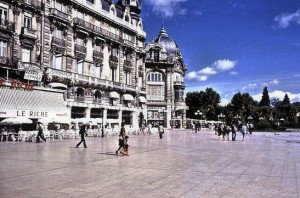
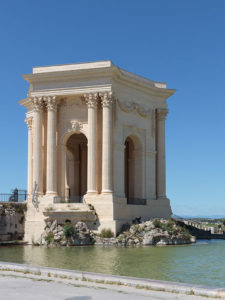
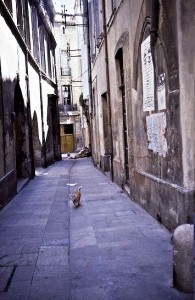



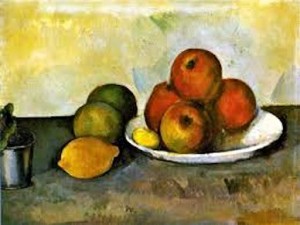
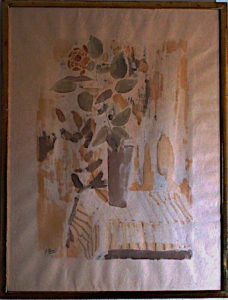

Restored: Original comment on 10 Sep 2013 at 11:46
Lovely piece of writing with a far better title. I believe you made other changes but I’m not sure. Great description of southern France at that period especially Montpellier. I would have like to see a pic of the “le château d’eau du Peyrou, with its aqueduct, dating from the 17 century. It must be the most beautiful water tower ever built”. Keep up the good work. Perhaps put a link at the end of a chapter like this one to the next chapter.
Pingback: Sketches from the Life of a Wandering Swede | Siv’s sketches from her life